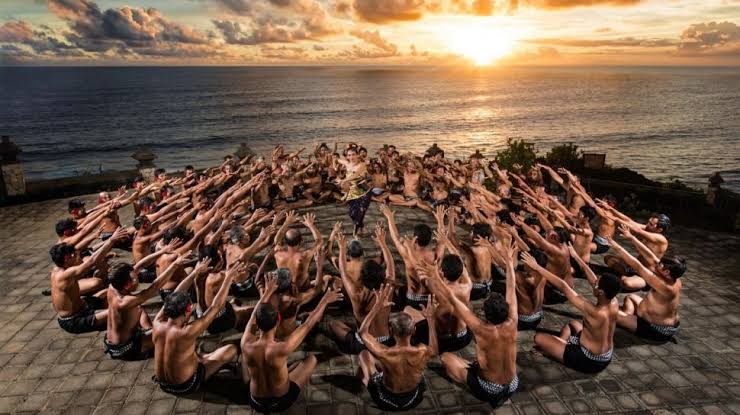KUPASONLINE.COM — IndonesianIndonesian culture is very diverse, and its diversity is even well-known throughout the world. Talking about traditional Indonesian dances, all of them have their own history and noble values. One of the dance arts that is owned and needs to be preserved is the Kecak Dance. This dance has a story, history, to its distinctive dance philosophy.
The dance originates from the island of Baliisland of Bali. The island, which is famous for its many tourist destinations, has a uniqueunique dance called Kecak. With its uniqueness, this dance is liked by some immigrant communities who are interested in learning it.
“Cak, Cak, Cak” is the distinctive sound that you usually hear when you see the Balinese Kecak Dance performance. This Kecak dance is a dance drama art that is played by 50 to 150 dancers.
As the name implies, this dance consists of dancers, mostly men who sit cross-legged in a circle. The clothes he wore were in the form of a sarong and a square cloth which had a black and white color like a chessboard which was tied in a circle to the dancer’s waist.
For those of you who are traveling or living in Balitraveling or living in Bali, of course you are already familiar with the Kecak Dance. This dance is performed when there are events, guests, or others. Apparently attracting the sympathetic audience or visitors who come to see it. However, behind the popularity of this dance, there is an origin, history, meaning, and some of the properties used in this dance.
To get to know more about the Kecak Dance. Let’s look at the following discussion.
The Kecak dance is one of the most popular dances on the island of Bali. Not only famous, this dance is usually also used as a ceremony to welcome guests, as well as religious ceremonies.
So, however, do you know how the Kecak Dance originated in ancient times so that it can become quite popular today? The following is a complete discussion of the origin of the traditional art dance called the Kecak Dance.Kecak Dance.
Kecak dance is one of the dances originating from Bali. This dance is also known as the Fire Dance or Cak Dance. This dance is a mass entertainment performance dance. This dance is performed by several male dancers, wearing a black and white checkered cloth covering the shape of a chessboard.
This dance is played without using musical accompaniment in the form of a gamelan. By sitting in a row to form a circle pattern and accompanied by a rhythmic call that reads “cak, cak, cak” while raising both hands.
This dance is a sacred dance. It can be seen from the dancers who are burned by fire, but they do not experience pain and are not burned, instead they become immune to fire.
Apart from the Fire Dance or Cak Dance, the Kecak Dance is also known as the Sanghyang Dance which is performed during religious ceremonies.
At that time, these dancers were generally possessed by spirits, and could interact with the ancestors or gods who had been purified by them. He used this dancer as a medium to convey His word. When possessed, they also perform actions beyond expectations. For example, doing some quite dangerous moves or making sounds that they rarely make.
Wayan Limbak is a creator figure of the Kecak Dance. In 1930, he introduced this dance to various countries, assisted by a painter from Germany named Walter Spies.
The male dancers who dance this, will shout the word “cak, cak, cak”. It was from this call that the name Kecak was created.
Not only shouting that word, the dancers are also accompanied by music in the form of rattles. The sound comes from the ring tied to the feet of the dancers from the Ramayana cast.
Inside the circle, the dancers then act. By playing a number of dances taken from several episodes of the Ramayana story, he tries to save Shinta from the evil hands of Ravana. Not a few of the Kecak Dance also involve visitors who are watching the dance action.
If you make a visit to travel to the island of Bali. Of course, it’s incomplete if you don’t see some of the most beautiful and captivating traditional performances this island has to offer. Apart from the Janger Dance and Bangor, there are other stunning performances that you shouldn’t miss, namely the Kecak Dance, which is one of the masterpieces of art from Bali in the form of dance and musical drama.
Shows performed in the open with the accompaniment of the wind before sunset. Usually held on a cliff overlooking the sea, the story is completely dependent on natural light at that time of day. Starting at dusk, the story continues in the dark, when there is only visible light
ng of the flickering bamboo torch.
This dance, which originates from the island of Bali, is not just a mere movement of the body, but there is a story in every movement that is meaningful
Do you know what are the meanings of this Kecak dance movement. Let’s look at the following understanding of the meaning of the Kecak dance movements.
When the dancers enter the stage, the story begins. Then, it was followed by Ravana bringing or kidnapping Shinta. Later, Ravana fights against Jatayu and Hanuman to save Shinta. During the rescue process, Hanuman disrupted Shinta’s captivity by setting fire to it.
However, Hanuman was surrounded by Ravana’s soldiers and almost burned. Initially, Rama did experience defeat. But this did not stop Rama from saving his empress, Shinta.
King Rama also prayed earnestly and again tried to bring back his queen. Until finally, Rama managed to get Shinta in a safe condition.
From that story, there is a quite deep meaning of the Kecak Dance, namely the belief in God’s power. This is reflected in Rama’s actions when asking the Gods for help.
Things like that teach a lesson that this dance is believed to be a ritual to summon a goddess who can drive away all harm, be it disaster or disease that befalls society.
Meanwhile, there is a moral message in the form of the Kecak dance which reflects Rama’s behavior towards his beloved empress, Shinta, and the Garuda bird, which is willing to sacrifice its wings for Shinta.(*)







